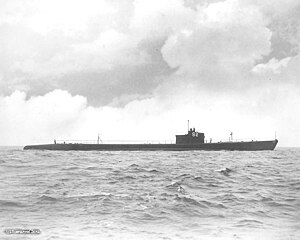USS Seal (SS-183)
 |
|
| History | |
|---|---|
|
|
|
| Builder: | Electric Boat Company, Groton, Connecticut |
| Laid down: | 25 May 1936 |
| Launched: | 25 August 1937 |
| Commissioned: | 30 April 1938 |
| Decommissioned: | 15 November 1945 |
| Struck: | 1 May 1956 |
| Fate: | Sold for scrap, 6 May 1957 |
| General characteristics | |
| Class and type: | Salmon-class composite diesel-hydraulic and diesel-electric submarine |
| Displacement: | 1,435 long tons (1,458 t) standard, surfaced, 2,198 long tons (2,233 t) submerged |
| Length: | 308 ft 0 in (93.88 m) |
| Beam: | 26 ft 1 1⁄4 in (7.957 m) |
| Draft: | 15 ft 8 in (4.78 m) |
| Propulsion: | 4 × Hooven-Owens-Rentschler (H.O.R.) 9-cylinder diesel engines (two hydraulic-drive, two driving electrical generators), 2 × 120-cell batteries, 4 × high-speed Elliott electric motors with reduction gears, two shafts, 5,500 shp (4.1 MW) surfaced, 2,660 shp (2.0 MW) submerged |
| Speed: | 21 knots (39 km/h) surfaced, 9 knots (17 km/h) submerged |
| Range: | 11,000 nautical miles (20,000 km) @ 10 knots (19 km/h) |
| Endurance: | 48 hours @ 2 knots (3.7 km/h) submerged |
| Test depth: | 250 ft (76 m) |
| Complement: | 5 officers, 54 enlisted |
| Armament: | 8 × 21-inch (533 mm) torpedo tubes (four forward, four aft; 24 torpedoes), 1 × 3 in (76 mm)/50 cal deck gun, four machine guns |
USS Seal (SS-183), a Salmon-class submarine, was the second ship of the United States Navy to be named for the seal, a sea mammal valued for its skin and oil. Her keel was laid down on 25 May 1936 by the Electric Boat Company in Groton, Connecticut. She was launched on 25 April 1937 at the Naval Submarine Base, New London, sponsored by Mrs. Rosemary G. Greenslade, wife of Lieutenant (later Rear Admiral) John F. Greenslade and daughter-in-law of Rear Admiral John W. Greenslade. The boat was commissioned on 30 April 1937, Lieutenant Karl G. Hensel in command.
Following an extended shakedown cruise in the Caribbean Sea and a post-shakedown yard period, Seal departed New England in late November and proceeded to the Panama Canal Zone to commence operations out of her home port, Coco Solo. Arriving on 3 December, she conducted local operations off Balboa, Panama, and off Coco Solo into January 1939, then proceeded to Haiti where she participated in type exercises prior to Fleet Problem XX. That exercise, to test the fleet's ability to control the approaches to Central America and South America, was conducted during late February in the Lesser Antilles.
In March, Seal returned to the Haiti–Cuba area for exercises with Destroyer Division 4 (DesDiv 4). In April, she proceeded to New London, Connecticut, for overhaul which included modification of her main engines. In June, the submarine again sailed south, transited the Panama Canal, and continued on to San Diego, California, and Pearl Harbor. In Hawaii from July to September, she took soundings for the Hydrographic Office and participated in various local exercises. At the end of the latter month, she returned to San Diego, her home port into 1941.
...
Wikipedia
